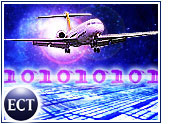Americans are driving online advertising to new heights as a result of their increasing “per-person daily media use,” primarily on the Internet, according to investment banking firm Veronis Suhler.
Suhler’s 14th Annual Communications Industry Forecast, released Monday, predicted that Internet advertising will more than quadruple to $24.4 billion (US$) by 2004, surpassing cable, satellite and network television, as well as consumer magazines.
The study said the communications sector was the fastest growing part of the U.S. economy from 1994 through 1999 and is expected to maintain that lead, mainly because individual media use is expected to continue to rise, passing 10 hours a day by 2004.
No Time to Sleep
“The communications industry has become a keystone in the U.S. economy,” Veronis Suhler executive vice president James Rutherfurd said. “To meet their demands and appetites, Americans have become expert media multi-taskers.”
Added Rutherfurd, “We’ve arrived at a point where consumption of media and information accounts for more than half of our waking hours.”
Traditional Media Advertise on Net
Traditional media has exploited the Internet boom by joining it. Most now have an Internet presence and spend heavily on online advertising.
Overall advertising spending grew 9.1 percent to $165 billion in 1999 and is expected to reach $249.1 billion in 2004, a growth rate of 8.6 percent. Internet advertising, which rose 140.6 percent to $4.6 billion in 1999, should continue to drive that growth spurt, accounting for a quarter of all advertising growth through 2004.
Per-person use of daily papers and consumer magazines will continue to drop slightly, the study forecast, although ad spending in both media rose the last five years and is expected to continue.
Media Heads the Pack
Media companies will form the fastest growing industry in the U.S. economy through 2004, according to the bank, which described its study as the “most comprehensive accounting of consumer usage and advertising spending trends across the full bandwidth of the communications industry.”
Total industry spending grew 8.1 percent from $524.7 billion in 1999 and is forecast to reach $745.8 billion in 2004, the study said. The growth rate of 7.8 percent compares favorably to the 4.7 percent growth rate predicted in nominal gross domestic product for the same period.
Growth has been spurred by the Internet, online video games, radio and recorded online music, which has become wildly popular due to free music-swapping services such as Napster.
Business Information Sector Remains Healthy
The study noted one of the faster-growing segments in the industry is business information services, even in light of “downward pricing pressure” caused by a proliferation of new forms of data collection and delivery.
More users are buying individual reports and articles, and individuals are accessing services previously aimed at big businesses.
“Consumers are increasingly using credit cards to purchase specialized information online,” the report said.
The study said that this usage explosion is being driven by “increased bandwidth, lower download times, rapid online data collection, conversion of massive data bases to online format and creative new methods of screening, sorting and organizing data.”
Access Spending To Rise Moderately
The study pointed out that although the number of online U.S. households soared 42 percent to 40.5 million in 1999 — and spending on access rose 52 percent to $9.4 million — spending on access is expected to rise only moderately as providers offer cheaper services. Per-houocariesehold spending is expected to shrink from $232 per year in 1999 to $217 per year in 2004.
Broadband Internet access is forecast to jump to 18.9 million subscribers in 2004, up from its current 2.1 million. Broadband spending is also expected to rise moderately as the service becomes more available.









































Social Media
See all Social Media